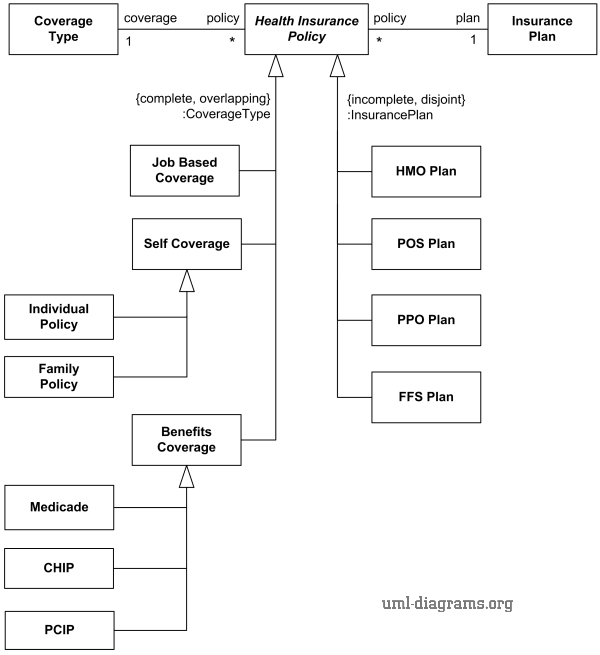Health Insurance Policy
UML Class Diagram Example
This is an example of UML domain diagram describing some Health Insurance Policy.
Various health insurance choices and options for a job based, public, and private coverage, together with health insurance plans are described on a website of the U.S. Department of Health and Human Services HealthCare.gov.
Several generalizations of the Health Insurance Policy could be grouped into generalization set Coverage Type. This set includes policies grouped by a coverage type - Job Based Coverage, Self Coverage, and Benefits Coverage.
People that have a job may be eligible for a health insurance coverage through work – either their own job or of their spouse or parent. If a person can’t get insurance through the employer, he or she have a number of other options either through self coverage and/or by using some benefits coverage.
If person cannot get health insurance through work, he or she may be able to buy a health insurance policy for self or his/her family (individual or family insurance policies).
People who have private health insurance can also be eligible for Medicaid. This is one of the reasons for the CoverageType generalization set to have {overlapping} constraint.
Each US state operates a Medicaid program that provides health coverage for lower income people, families and children, the elderly, and people with disabilities. All states provide coverage for eligible children through Medicaid and the Children’s Health Insurance Program (CHIP). People who have a pre-existing health condition and have been uninsured for the past six months, may qualify for the Pre-Existing Condition Insurance Plan (PCIP) created under the Affordable Care Act.

Health insurance policy example UML class diagram with generalization sets and power types.
Another generalization set for the Health Insurance Policy could be grouped by the insurance plan. Some common types of health insurance plans are Health Maintenance Organization (HMO), Point Of Service (POS), Participating Provider Option (PPO), and Fee For Service (FFS). Because this list is incomplete, as there are other insurance plans, Insurance Plan generalization set has {incomplete} constraint. Usually there is no overlapping in insurance plans, that is the reason for another {disjoint} constraint.
The HMO is one of the most affordable and common as a family health insurance choice. Usually it restricts patients to receive health care from certain "in-network" doctors and hospitals (health care providers). The PPO is another popular and flexible choice for families, as it provides both coverage from preferred in-network providers, while also allowing to get help from out-of-network health care providers. The POS plan is a combination of HMO and PPO. The FFS plan usually provides the same coverage from all available health care providers, while it does not work with any health care provider networks. Most services are covered because it is the most expensive health insurance plan.